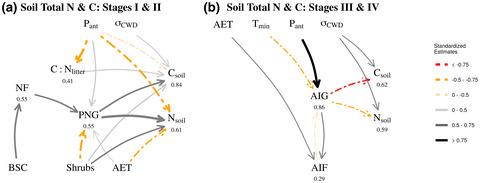当前位置:
X-MOL 学术
›
Glob. Change Biol.
›
论文详情
Our official English website, www.x-mol.net, welcomes your feedback! (Note: you will need to create a separate account there.)
Interannual climate variability mediates changes in carbon and nitrogen pools caused by annual grass invasion in a semiarid shrubland
Global Change Biology ( IF 11.6 ) Pub Date : 2021-10-06 , DOI: 10.1111/gcb.15921 Adam L Mahood 1, 2 , Rachel O Jones 3 , David I Board 4 , Jennifer K Balch 1, 2 , Jeanne C Chambers 4
Global Change Biology ( IF 11.6 ) Pub Date : 2021-10-06 , DOI: 10.1111/gcb.15921 Adam L Mahood 1, 2 , Rachel O Jones 3 , David I Board 4 , Jennifer K Balch 1, 2 , Jeanne C Chambers 4
Affiliation

|
Exotic plant invasions alter ecosystem properties and threaten ecosystem functions globally. Interannual climate variability (ICV) influences both plant community composition (PCC) and soil properties, and interactions between ICV and PCC may influence nitrogen (N) and carbon (C) pools. We asked how ICV and non-native annual grass invasion covary to influence soil and plant N and C in a semiarid shrubland undergoing widespread ecosystem transformation due to invasions and altered fire regimes. We sampled four progressive stages of annual grass invasion at 20 sites across a large (25,000 km2) landscape for plant community composition, plant tissue N and C, and soil total N and C in 2013 and 2016, which followed 2 years of dry and wet conditions, respectively. Multivariate analyses and ANOVAs showed that in invasion stages where native shrub and perennial grass and forb communities were replaced by annual grass-dominated communities, the ecosystem lost more soil N and C in wet years. Path analysis showed that high water availability led to higher herbaceous cover in all invasion stages. In stages with native shrubs and perennial grasses, higher perennial grass cover was associated with increased soil C and N, while in annual-dominated stages, higher annual grass cover was associated with losses of soil C and N. Also, soil total C and C:N ratios were more homogeneous in annual-dominated invasion stages as indicated by within-site standard deviations. Loss of native shrubs and perennial grasses and forbs coupled with annual grass invasion may lead to long-term declines in soil N and C and hamper restoration efforts. Restoration strategies that use innovative techniques and novel species to address increasing temperatures and ICV and emphasize maintaining plant community structure—shrubs, grasses, and forbs—will allow sagebrush ecosystems to maintain C sequestration, soil fertility, and soil heterogeneity.
中文翻译:

年际气候变率调节半干旱灌丛年草入侵引起的碳和氮库变化
外来植物的入侵改变了生态系统的特性并威胁到全球的生态系统功能。年际气候变率 (ICV) 影响植物群落组成 (PCC) 和土壤性质,ICV 和 PCC 之间的相互作用可能影响氮 (N) 和碳 (C) 库。我们询问 ICV 和非原生一年生草入侵如何影响半干旱灌木丛中的土壤和植物 N 和 C,该灌木丛由于入侵和改变的火势而正在经历广泛的生态系统转变。我们在一个大型(25,000 km 2) 2013 年和 2016 年植物群落组成、植物组织 N 和 C 以及土壤总 N 和 C 的景观,分别遵循 2 年的干湿条件。多变量分析和方差分析表明,在原生灌木和多年生草类群落被一年生草类群落取代的入侵阶段,生态系统在潮湿年份损失了更多的土壤氮和碳。路径分析表明,高可用水导致所有入侵阶段的草本覆盖率较高。在原生灌木和多年生草的阶段,较高的多年生草覆盖率与土壤 C 和 N 的增加有关,而在以年为主的阶段,较高的年草覆盖率与土壤 C 和 N 的损失有关。此外,土壤总 C 和 C :如站点内标准偏差所示,N 比率在年度主导的入侵阶段更为均匀。原生灌木和多年生草和杂草的丧失,加上每年的草入侵,可能导致土壤氮和碳的长期下降,并阻碍恢复工作。使用创新技术和新物种来解决温度升高和 ICV 问题并强调维持植物群落结构(灌木、草和杂草)的恢复策略将使山艾树生态系统能够保持碳封存、土壤肥力和土壤异质性。
更新日期:2021-12-03
中文翻译:

年际气候变率调节半干旱灌丛年草入侵引起的碳和氮库变化
外来植物的入侵改变了生态系统的特性并威胁到全球的生态系统功能。年际气候变率 (ICV) 影响植物群落组成 (PCC) 和土壤性质,ICV 和 PCC 之间的相互作用可能影响氮 (N) 和碳 (C) 库。我们询问 ICV 和非原生一年生草入侵如何影响半干旱灌木丛中的土壤和植物 N 和 C,该灌木丛由于入侵和改变的火势而正在经历广泛的生态系统转变。我们在一个大型(25,000 km 2) 2013 年和 2016 年植物群落组成、植物组织 N 和 C 以及土壤总 N 和 C 的景观,分别遵循 2 年的干湿条件。多变量分析和方差分析表明,在原生灌木和多年生草类群落被一年生草类群落取代的入侵阶段,生态系统在潮湿年份损失了更多的土壤氮和碳。路径分析表明,高可用水导致所有入侵阶段的草本覆盖率较高。在原生灌木和多年生草的阶段,较高的多年生草覆盖率与土壤 C 和 N 的增加有关,而在以年为主的阶段,较高的年草覆盖率与土壤 C 和 N 的损失有关。此外,土壤总 C 和 C :如站点内标准偏差所示,N 比率在年度主导的入侵阶段更为均匀。原生灌木和多年生草和杂草的丧失,加上每年的草入侵,可能导致土壤氮和碳的长期下降,并阻碍恢复工作。使用创新技术和新物种来解决温度升高和 ICV 问题并强调维持植物群落结构(灌木、草和杂草)的恢复策略将使山艾树生态系统能够保持碳封存、土壤肥力和土壤异质性。


























 京公网安备 11010802027423号
京公网安备 11010802027423号